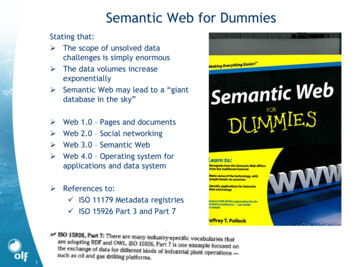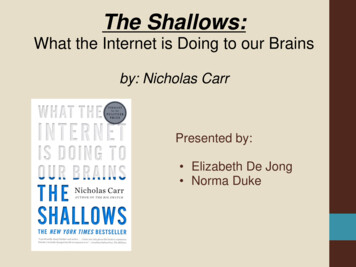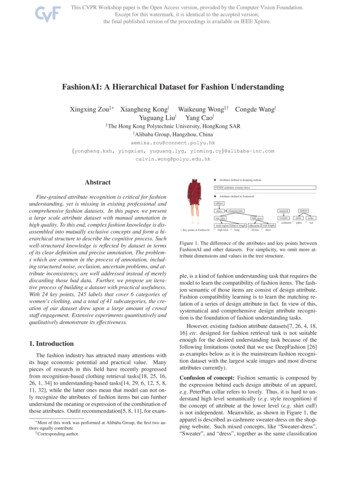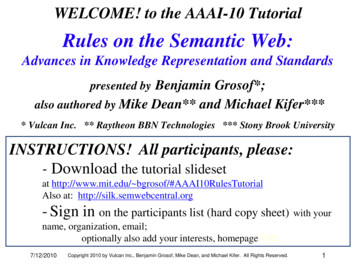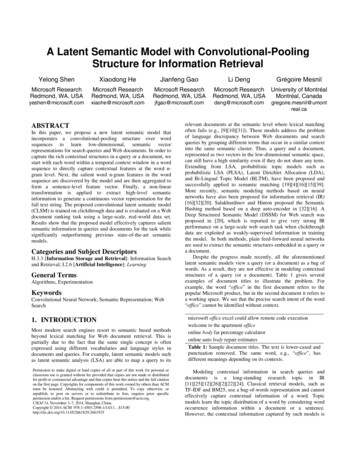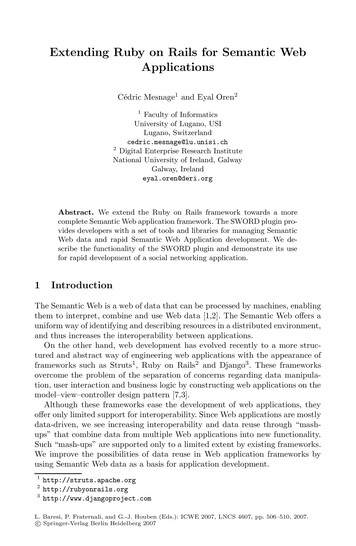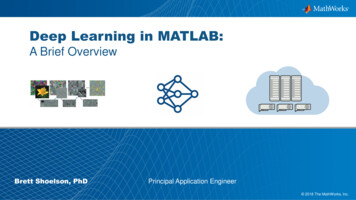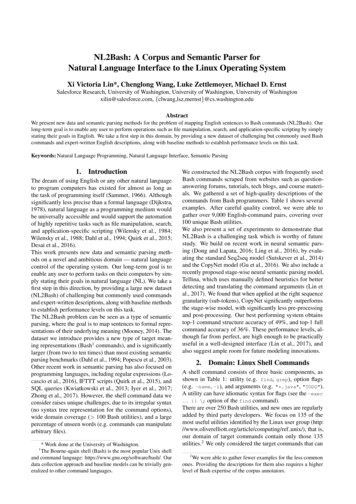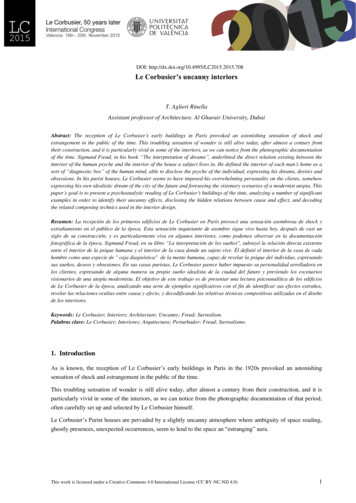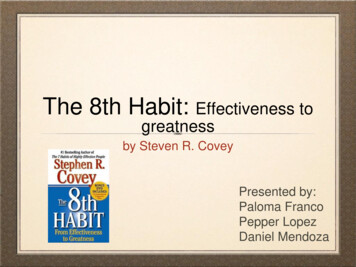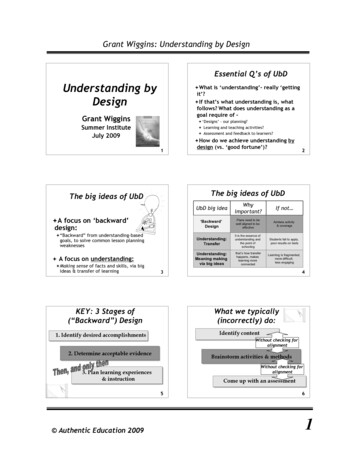
Transcription
Grant Wiggins: Understanding by DesignEssential Q’s of UbDUnderstanding byDesign What is ‘understanding’- really ‘gettingit’? If that’s what understanding is, whatfollows? What does understanding as agoal require of -Grant Wiggins ‘Designs’ - our planning?Summer InstituteJuly 2009 Learning and teaching activities? Assessment and feedback to learners? How do we achieve understanding by1 A focus on ‘backward’design: “Backward” from understanding-basedgoals, to solve common lesson planningweaknesses A focus on understanding: Making sense of facts and skills, via bigUbD big ideaWhyimportant?If not ‘Backward’DesignPlans need to bewell aligned to beeffectiveAimless activity& coverageUnderstanding:TransferIt is the essence ofunderstanding andthe point ofschoolingStudents fail to apply,poor results on testsUnderstanding:Meaning makingvia big ideasthat’s how transferhappens, makeslearning moreconnectedLearning is fragmented,more difficult,less engaging3KEY: 3 Stages of(“Backward”) Design4What we typically(incorrectly) do:Identify content1. Identify desired accomplishmentsWithout checking foralignment2. Determine acceptable evidenceBrainstorm activities & methodsWithout checking foralignment3. Plan learning experiences& instructionCome up with an assessment5 Authentic Education 20092The big ideas of UbDThe big ideas of UbDideas & transfer of learningdesign (vs. ‘good fortune’)?61
Grant Wiggins: Understanding by DesignWhy UbD? Problem statements: Too many courses are just ‘coverage’focused Most local assessments are not higherorder Lesson planning is done in isolationfrom long-term goals Students perform poorly on higherorder tests and performances Students do not transfer learning7Why UbD? 3 useful Q’s to askas kids work:8The course is not the textbook The textbook CANNOT be a What are you doing?complete course - it is a resource Why are we doing it? It is a jam-packed & incoherent resource, to be What will it help us be able Like an encyclopedia, it provides mostlysold in 50 states (esp. CA, FL, TX)‘logically’ organized content - not anoptimally-framed syllabus to achieve specificlocal goals and prioritiesto understand/do (thatmatters)?910Toward Valid Curriculum: Focuson Priority outcomesworth beingfamiliar withimportant toknow & doBig ideas& core transfertasks“nice to know”importantknowledge & skill“big ideas”& core transfer tasksat theheart of the subject11 Authentic Education 2009UbD big ideaWhyimportant?If not BackwardDesignPlans need to bewell aligned to beeffectiveAimless activity& coverageUnderstanding:TransferIt is the essence ofunderstanding andthe point ofschoolingStudents fail to apply,poor results on testsUnderstanding:Meaning makingvia big ideasthat’s how transferhappens, makeslearning moreconnectedLearning is fragmented,more difficult,less engaging122
Grant Wiggins: Understanding by DesignUBD TemplateContent mastery a means,shaped by goalsStage 1 - Desired Results TheTemplate–Other Evidence:Stage 2 - AssessmentEvidencePerformance TasksOther EvidenceOther Evidence:Stage 3 - LearningPlan If content mastery is the means,what is the desired end? Designed toaddress theproblems weidentified What in the future should studentsbe able to achieve? Why is this worth learning? What ofit?13Backward Design from‘Coverage’“I want students to go toFrance to -1414Backward Design from‘Coverage’“I want students to go to France to 1) see all the important sites in Paris 2) experience the culture 3) hear and speak the language” 1) see all the important sites in Note that this is not really a goalParis 2) experience the culture 3) hear and speak the language”statement. It describes someactivities, not any specificlearnings desired from doingactivities.15Goal vs. skillBackward from true Goals “I want students to learn Students need to learn toto decode”decode - along with other skills –in order to successfullycomprehend and find value inwhat they read, on their ownThis is a skill; what’s the pointof the skill? What’s the goal?17 Authentic Education 200916183
Grant Wiggins: Understanding by DesignBackward design from ‘contentcoverage’Backward Design from Goals I want students to leave my course havingunderstood that – I want students to understand – The Constitution The 3 branches of governmentNo - not a learning goal - thisjust says what the content is The Constitution was a solution, based oncompromise, to real problems of balanceand limit of powers - in a long, sometimesbitter history – with many fights that arewith us and will always be with us.19Backward Design from theUnderstandings SoughtBackward Design from Goals I want students to be able to use that“I want students to come home from France havinglearned that 201) What countries build monuments to is a telling culturalinsight. What do Paris monuments tell us?2) Americans can appear ‘ugly’ if they are not attentive to howsome of what is ‘natural’ to us is naturally ‘rude’ to them. Am Iunwittingly acting like an Ugly American?3) Travel abroad is most rewarding when you take the risk touse the language, and appear eager to learn from natives”.What’s holding me back from trying to speak in French? Howcan I more readily take the ‘risk’ and have fun doing so?understanding to – See current struggles between the 3 branches ontheir own and have an informed opinion and transfer that understanding to A modern relevant situation: Design a government for Iraq A system of governance for our school21Content mastery the means22Backward Design: If content mastery is the means, what is theend? I want them tolearn [content] sothat, in the long run, they will beable, on their own to I want you to learn grammar so that, in thelong run, you are able, on your own to speakand write in any situation with precision,clarity, and maximum impact.[a long-term desired accomplishment, involvingimportant transfer & extension of learning] SO: you have to design your courses BACKWARDfrom the kinds of communication challengesthat depend upon precise grammar23 Authentic Education 2009244
Grant Wiggins: Understanding by DesignBackward Design ofCurriculum:what follows from the goalsAMT - We have 3 GoalsAcquire Note that you design backward fromthe ability of students to use‘content’ to make new connectionsand transfer Just like sports: you haven’t ‘gottenit’ unless you can ‘see it’ and ‘use’ it‘in the game’25‘Intelligent use’ of contentacquired is the ultimate goalMakeMeaningimportantknowledgeand skillsof & with “bigideas”TransferLearning tonew situationsSee “Put Understanding First” in Educational LeadershipMay 2008, Volume 65, #8 Pages 36-4126Many teachers mistakenly thinkthat acquisition is the only goal Even the MO state standards make this You acquire knowledge, skill, andclear in distinguishing the Show MeStandards (performance) from thefoundational Standards (content)understanding to use them togethereffectively Understand when to use whichknowledge and skill, and how to usethem all wisely in new situations “The standards are built around the belief27Many teachers mistakenlythink that acquisition is theonly goalthat the success of Missouri’s studentsdepends on both a solid foundation ofknowledge and skills and the ability ofstudents to apply their knowledge and skillsto the kinds of problems and decisions theywill likely encounter after they graduate.”28i.e. - not a good way to learnto drive a car. “The academic standards incorporateand strongly promote the understandingthat active, hands-on learning willbenefit students of all ages. Byintegrating and applying basicknowledge and skills in practical andchallenging ways across all disciplines,students experience learning that ismore engaging and motivating. Suchlearning stays in the mind long after thetests are over and acts as a springboardto success beyond the classroom.29 Authentic Education 2009305
Grant Wiggins: Understanding by DesignKey problem: wrongly treatingtextbook as the syllabusFrom the MO Standards: These standards for students arenot a curriculum. Rather, thestandards serve as a blueprintfrom which local school districtsmay write challenging curriculumto help all students achieve theirmaximum potential The textbook is just a collection ofrelatively discrete lessons and drills,not a purposeful, integrated, andmission-focused course of study In the best designs, therefore: thetextbook is a resource used withdiscretion, not the syllabus31Intelligent use of textbooks1. Syllabus written before textbookschosen2. Syllabus is based on Standards, bigideas, transfer goals3. Thus: Which chapters highlighted,which skimmed, which skipped, giventhe Standards?4. What activities and assessmentsneeded beyond what the textbooksupplies?32UbD big ideaWhyimportant?If not BackwardDesignPlans need to bewell aligned to beeffectiveAimless activity& coverageUnderstanding:TransferIt is the essence ofunderstanding andthe point ofschoolingStudents fail to apply,poor results on testsUnderstanding:Meaning makingvia big ideasthat’s how transferhappens, makeslearning moreconnectedLearning is fragmented,more difficult,less engaging3334Transfer defined andjustified What is ‘transfer of learning’? ‘Transfer of learning’ is the use of knowledge andskills (acquired in an earlier context) in a newcontext. It occurs when a person’s learning in onesituation influences that person’s learning andperformance in other situations. When transfer of learning occurs, it is in the formof meanings, expectations, generalizations,concepts, or insights that are developed in onelearning situation being employed in othersexample:getting your driver’s license Bigge & Shermis, 1992.35 Authentic Education 2009366
Grant Wiggins: Understanding by DesignWe often confuse the drills withthe gameThe Transfer Question: ‘Drills’ - test What should the student be able to doeffectively with a repertoire ofknowledge and skill, increasingly on theirown, in future tasks at the heart of trueexpertise? How, then, will transfer ability bedeveloped over the course of the course?items Short-term objective Out of context Discrete, isolatedelement set up and promptedfor initial simplifiedlearning Doesn’t transfer tonew situations on itsown The ‘game’ - real task The point of the drills In context, with all itsmessiness and interestvalue Requires a repertoire,used wisely Not prompted: you judgewhat to do, when37Gradual Release of TeacherResponsibility I do, you watch I do, you help You do, I help You do, I watch‘Gradual Release’ in History,for example The transfer goal: you can analyze andinterpret any unfamiliar primary andsecondary source document on your own (I.e.no clues, scaffolds, hints). Gradual release means you have to learn document-reading strategies and This is a general schema for thedevelopment of transfer ability at anyage, in any subject39‘Gradual Release’ in Math, forexample The transfer goal: you can solve any complexunfamiliar problem on your own (I.e. no clues,scaffolds, hints) in which context matters. Gradual release means you have to learn problem-solving strategies and usethem with decreased teacher hints, and learn fromfeedback - just like the reader and the athlete Provide various practice problems like the NAEP busproblem, in which the context variables change andincrease the complexity41 Authentic Education 200938use them with decreased teacher hints, and learnfrom feedback - just like the reader and the athlete Provide various DBQ practice problems, in which thecontext variables change and increase the complexity40What research says onteaching for transferHalpern and Hakel, in Change: “The single most important variable in promotinglong-term retention and transfer is "practice atretrieval." This principle means that learnersneed to generate responses, with minimal cues,repeatedly over time, with varied applications sothat recall becomes fluent and is more likely tooccur across different contexts and contentdomains.”427
Grant Wiggins: Understanding by DesignState tests demandautonomous transfer!Research on transfer: An especially sensitive way to assess the degree to which students'learning has prepared them for transfer is to use methods such as"graduated prompting". This method can be used to assess the amount ofhelp needed for transfer by counting the number and types of promptsthat are necessary before students are able to transfer. Some learners can transfer after receiving a general prompt such as"Can you think of something you did earlier that might be relevant?"Other learners need prompts that are much more specific. Tests oftransfer that use graduated prompting provide more fine-grainedanalysis of learning and its effects on transfer than simple one-shotassessments. Every formal testing situationrequires prior release of teacherresponsibility: Student gets no hints, scaffold, contextclues From How People Learn Student has to ‘read strategically’ –figuring out what to do when.43Irony: the most difficult testquestions involve TRANSFER, notrecall4444Irony: that’s what the difficultproblems are - TRANSFER problems Unfamiliar reading passagesand writing prompts – youhave to transfer all your priorlearning to a new text, out ofcontext Novel-looking versions ofmath and science problems,with no clues here from thetextbook or teacher as towhich skills apply now4545FCAT - FloridaFCAT47 Authentic Education 20094646488
Grant Wiggins: Understanding by DesignFCAT4950MCAS - math 10th grFCAT 10th grade Reading From a Boston Globe article: The hardest question on the mathsection, which just 33 percent gotright, asked students to calculate thedistance between two points.5152MCAS 10th gr EnglishPurpose Question Edmund Spenser lived from 1552-1599. Read his poem "Sonnet 26" below. Usethe information from the poem to answer the questions. 5 10 What is the purpose of the last two lines of the poem?Sweet is the rose, but grows upon a briar;Sweet is the juniper, but sharp his bough,Sweet is the eglantine,¹ but pricketh near;Sweet is the fir bloom, but his branch is rough;Sweet is the cypress, but his rind is tough;Sweet is the nut, but bitter is his pill;Sweet is the broom flower, but yet sour enough;And sweet is moly,² but his root is ill.So every sweet with sour is tempered still,That maketh it be coveted the more:For easy things, that may be got at will,Most sorts of men do set but little store.Why then should I account of little pain,That endless pleasure shall unto me gain!A.B.C.D.53 Authentic Education 2009to add humor to the poemto reassert the speaker’s angerto summarize the poem’s meaningto repeat the poem’s visual imageryState Average: 68%549
Grant Wiggins: Understanding by DesignTypicalResponseNAEP: Dishpan Ducksby Margaret Springer “Choose the Best Title” In the story, Rosa enjoys spending time atthe creek behind her apartment building. Do you think “Rosa’s Creek” would be abetter title than “Dishpan Ducks”? Useevidence from the story to compare bothtitles and to explain which title is better.55Copyright 2008 Mississippi Department of Education56NAEP: High Score described Only 18% of students showedevidence of full comprehension. ‘Full comprehension’: These responses provide an opinion about which titleis better by discussing both titles or by providingmultiple pieces of linked information in support ofone title. Responses may suggest that neither title is betterthan the other so long as they provide support for theopinion. Responses may provide an alternative title andsupport that title with at least two pieces of linked57information.Copyright 2008 Mississippi Department of Education58MCAS (MASS) test item: 10thgrade English reading itemA fellow fourth grader broke the news to me after she saw my efforton a class assignment involving scissors and construction paper. “You cut outa purple bluebird,” she said. There was no reproach in her voice, just a certainpuzzlement. Her observation opened my eyes— not that my eyes particularlyhelp—to the fact that I am colorblind. In the 36 years since, I’ve been trying tounderstand what that means. I’m still not sure I do .Unlike left-handers, however, we seem disinclinedto rally round our deviation from the norm. Thus there’s no ready source ofinformation about how many presidents, or military heroes, or rock singershave been colorblind. Based on the law of averages, though, there must havebeen some. We are everywhere, trying to cope, trying to blend in. Usually wesucceed. Until someone spots our purple bluebirds. Then the jig is up.59 Authentic Education 2009606010
Grant Wiggins: Understanding by DesignThe most wrong item on thestate test: 71% incorrect!Transfer the real ‘game’ ofusing content on your ownThis selection is best described as - Applying prior learning to -A. a biography.B. a scientific article.C. an essay.D. an investigative report. a novel and increasingly new and unfamiliar-looking taskMany students said it could not be anessay because “it was funny” andbecause “it had more than 5paragraphs.” An increasingly challenging context & situation(in terms of purpose, audience, dilemmas,“noise” etc.)6161Note how this goal changes ourview of time use!62The problem: local practices –especially inassessment - typically do not derive from oralign with long-term goals What will we do to achieve theperformance goal - given the verylimited time we have? We do NOT say: sorry, no time forperformance-based learning and assessment there is too much information to cover! Nor do we make this mistake in the arts,athletics, writing, speaking a language63Math unit: “What is Fair? Does math help?”Intro problem: Four7th-grade classes hada race of all thestudents. Devise asmany ways as you canto determine a fairranking of the 4classes, given theindividual runnerresults in the table.Summarize the 2-3top ways you thinkwould be most fair,and be prepared to65discussyour answers 64Other question-framingactivities/discussions What do we mean when we say that the rules ofIndividual ranking of runners in arace by all 7th-grade classes 65 Authentic Education 2009a game of chance are “not fair”? What role doesmath play in our judgment? Why is it fair to have one person cut the cakeand the other person to choose the piece? When is straight majority voting “fair” andwhen is it “not fair”? When is it “fair” to consider an “average” inranking performance (e.g. salaries, homeprices, batting average) and when is it “unfair”?6611
Grant Wiggins: Understanding by DesignThe content is learned on theway, as a meansFinal task in the unit onmean/median/mode So, what is a fair grade? What mathematical tools are well Based on our study in this unit of various measuresof central tendency, and the pros and cons of using“averages” (and other such measures) in varioussituations, Propose and defend a “fair” gradingsystem for use in this school. How should everyone’sgrade in classes be calculated? Why is your systemmore fair than the current system (or: why is thecurrent system most fair?)suited to judging fairness? Measures of central tendency: Mean Median Mode Quizzes to check for skill development A final reflection on the unit, based on the essentialquestion “What is fair? Does math help us?”6768How people learnUbD big ideaWhyimportant?If not BackwardDesignPlans need to bewell aligned to beeffectiveAimless activity& coverageUnderstanding:TransferIt is the essence ofunderstanding andthe point ofschoolingStudents fail to apply,poor results on testsUnderstanding:Meaning makingvia big ideasthat’s how transferhappens, makeslearning moreconnectedLearning is fragmented,more difficult,less engaging A major goal of schooling is to prepare students forflexible adaptation to new problems and settings.The ability of students to transfer provides animportant index of learning that can help teachersevaluate and improve their instruction. Students develop flexible understanding of when,where, why, and how to use their knowledge tosolve new problems if they learn how to extractunderlying principles and themes from their learningexercises. - How People Learn, Natl Academy of Sciences69A ‘big idea’ is a working andeffective ‘meaning’ - a useful‘theory’, ‘schema’ or ‘theme’To make meaning is to, onyour own,. Consider detectives at work: Who has the motive? Might this be a love triangle, we ‘Connect the dots’should follow the money, etc. Make sense of (seemingly isolated) ‘Theory’ in science/math -experiences, facts, text Identify the gist, point, purpose,significance Draw appropriate inferences Look for the most parsimonious explanation ‘Theme’ Boy finds girl, boy loses girl, boy finds girl The American Dream History as a history of progress71 Authentic Education 2009707212
Grant Wiggins: Understanding by DesignArguably a very big idea indriving:Transfer based on meaningfulideas permits future learning “The first object of any act of learning, over and Anticipate: assume thebeyond the pleasure it may give, is that it shouldserve us in the future. In essence, it consists inlearning initially not a skill but a general ideawhich can then be used as a basis for recognizingsubsequent problems. This type of transfer is atthe heart of the educational process - the continualbroadening and deepening of knowledge in termsof.ideas.” Bruner, Process of Education p. 17other guy is an idiot73What idea can help us makesense out of.Critical Point!! All the really big ideas are not Clouds, puddles, disappearing puddles? Tides, falling objects, phases of themoon, Mars orbit Salem Witch Trials, Slavery, theHolocaust, the current economic collapse? No number can be divided by zero,negative numbers, any number to thezero power 1? Sarcasm, irony, tall tale? [any set of actions by a character]75Dewey said it decades ago: It would be impossible to over-estimate theeducational importance of arriving atconceptions: that is, meanings that aregeneral because applicable in a great varietyof different instances in spite of theirdifference.they are known points ofreference by which we get our bearingswhen we are plunged into the strange andunknown. Without this conceptualizing,nothing is gained that can be carried over tothe better understanding of new experiences. Dewey, 1933, p. 15377 Authentic Education 200974obvious to the novice! Often counter-intuitive Easy to misunderstand Require inference and active intellect,not just passive perception They are ‘obvious’ to the expert- and therein lies the challengeof teaching for understanding!76That’s Why EQs are soimportant Essential Questions signal thatactive inquiry and meaning-making isthe means and key to the goal Students learn that “acquisition” isdifferent from “meaning-making” Meaning-making is “in my head” not “on thepage” (QAR) Students learn that many schemas,theories need testing - and changing!7813
Grant Wiggins: Understanding by Design1st Stage of“Backward” DesignNew Pearson Lit. Series Is truth the same for everyone? Can all conflicts be resolved?1. Identify desired accomplishments How much information is enough? What is the secret to reaching2. Determine acceptable evidence3. Plan learning experiences& instruction79someone with words? Is it our differences or similaritiesthat matter most? Are yesterday’s heroes importanttoday?Key Qs: From Polya How toSolve ItFrom new Magruder’s Gov’ttext What is the unknown? What are the data? What isthe condition? Have you seen it before? Or have you seen thesame problem in a slightly different form? Can you see clearly that [each] step is correct?Can you prove that it is correct? Can you check the result? Can you check theargument? Can you derive the solution differently? Can you use the result, or the method, for someother problem?81 How much power should the federalgovernment have? What are the most pressing social problems andhow should they be addressed by government? When should America go to war? What is the proper balance between freeenterprise and government regulation of theeconomy? What is the proper balance between nationalsecurity and civil liberties? What is America’s role in the world?statements that sum upthe unobvious meaningof facts or experiences Specific full-sentencegeneralizations about theuse of facts and skills - astatement of wise butarguable strategy Summary insights, rulesof thumb, aphorisms “the moral of the story”as someone sees it82From Big Ideas toUnderstandings about themUnderstandings vs. facts Understandings - STAGE 1 Conclusions, inferences -80 Knowledge - STAGE 1 Facts to be taken andlearned as such Settled knowledge,accepted as true orgiven Obvious, unproblematicand straightforwardclaims83 Authentic Education 2009 An understanding is a “moral of thestory” about the big ideas What specific insights will students take away about the themeaning of ‘content’ via big ideas? Understandings summarize the desired insights we wantstudents to realize An understanding may be that there IS NO agreed-uponunderstanding! (e.g. in confusing data or historicalinterpretation)107ff8414
Grant Wiggins: Understanding by Designpp.117Toward ‘understandings’ viamisunderstandings!“Equivalence” Understandings about this ‘big idea’ in math: Recall we noted above that a big Quantities can be converted into many equalsymbolic forms: fractions - decimals; factoring andregrouping, etc. The essence of problem solving is finding the mostuseful equivalences - I.e. turning complex intosimple, unfamiliar into familiar, unknown intoknown. The same mathematical ideas can be representedconcretely, graphically, or symbolically. Contextdetermines which is most appropriate.idea has an unobvious, perhaps evenstrange and counter-intuitive aspectto it The water cycle vs. “it is gone” “Discuss with the author” even though theauthor cannot be there8586Sample ReadingMisconceptionsOther Misconceptions in math From 2061 Benchmarks (AAAS): Variables Students have difficulty understandinghow symbols are used in algebra. They are oftenunaware of the arbitrariness of the letters chosento represent variables in equations. Middle-schooland high-school students may regard the letters asshorthand for single objects, or as specific butunknown numbers before they understand them asrepresentations of variables. These difficultiestend to persist even after instruction in algebraand are evident even in college students.87 All the answers can be found by ‘looking it upin the book’ If I just keep scanning the lines, it willeventually make sense If I know all the words, I know what the textmeans The teacher, of course, knows ‘the’ answer toquestions about what the book really means The book means what any reader says itmeans88pp.136ffSample History Misconceptions2nd Stage of“Backward” Design History is about the facts of whathappened1. Identify desired accomplishments We know what happened - or at leastsomeone does; we can look it up andsettle the dispute. The people in the past believed odd andprimitive things; we know better. There is one major cause for an effect,and the key cause is obvious. Maps are objective facts.89 Authentic Education 20092. Determine acceptable evidence3. Plan learning experiences& instruction9015
Grant Wiggins: Understanding by DesignStage 2: What follows forassessment?What assessment forunderstanding implies Bloom and common sense say: Your thinking and support, not just your answer - The analytic challenge is to identify the“show your work”, the dissertation and its defenseULTIMATE tasks that embody the bottomline learning goals/purposes The ability to apply what you have learned to anovel problem or situation What real-world important tasks epitomize the Goal? Being able to perform, on your own, with minimal What projects should a student who has met the Standardprompting - to do the subjectbe able to do well? What is Mission Accomplished? What challenges in the worldshould students be prepared to handle and accomplish? The ability to adjust, as needed The ability draw inferences, on your own, from thefacts: generalize, compare & contrast, etc. The ability to argue/critique/evaluate the work ofothers as well as one’s own912 validity questions for apractical ‘test of the test’:Not the format that mattersbut what we are looking for!1. Could the test be passed, butwithout understanding?2. Could the specific testperformance be poor, but thestudent still reveal understanding invarious ways before, during, andafter?!2. Regardless of the type of test (quiz, essay,observation), what should we look for? where should we look?in order to say - they got it (or didn’t)?The goal is to answer NO to both93A unit example, geography:“Why there?”1.92Why There? (2)Consider: give each student a largetopographical map of the US (or your state,or an ancient region), and ask them toidentify places where big cities are mostlikely and least likely to be & say why.Now, give them a road map and ask ofvarious cities: Why there? What’s your‘theory’ about settlement & geography?2. Acquire: Read the relevanttextbook sections on the relationbetween geography andpopulation settlement. Quiz on the chapter - re: regions, settlement,geography95 Authentic Education 2009949616
Grant Wiggins: Understanding by DesignWhy There (4): Transfer YourLearningWhy there? (3)4.Further inquiry: test yourtheory What are the capitals of New Jersey, New York,Maryland, Illinois, and California; and why are theythere?Study local growth over the past 150 years in thestate: why here and not there?Jigsaw research & discussionCivic planning. You are a geographer hired tomake predictions about population trends overthe next century, based on maps, climate andtrade data.Using your understanding of the links betweengeography, settlement, migration, trade, andtransportation: advise the planning agencies ofthe government on what they can expect.Generalize - test your theory again (Students can be presented with modern maps of counties/states - ORmaps of colonial times or ancient river civ
Grant Wiggins: Understanding by Design Authentic Education 2009 1 1 Understanding by Design Grant Wiggins
